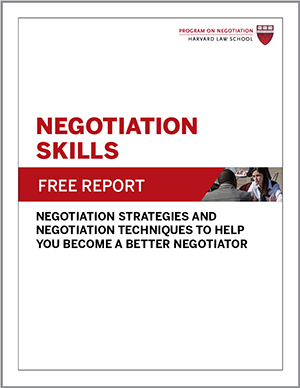
Nonverbal behavior, such as eye contact, gestures, and facial expressions, can be useful in breaking down barriers between people and establishing rapport. Somewhat surprisingly, little research has examined body language in negotiation, write Jeff Thompson, Noam Ebner, and Jeff Giddings in The Negotiator’s Desk Reference. But scattered results and anecdotal evidence suggest that certain nonverbal behaviors can go a long way toward establishing a connection with new counterparts and repairing relationships that have gone offtrack. Let’s take a closer look at how body language affects negotiation.
Eye Contact: A Vanishing Art?
Eye contact is a common tool for building a connection with someone. Unfortunately, it’s an underused form of nonverbal communication in negotiation. Ideally, we should be making eye contact for 60% to 70% of conversation time, according to research by communications-analytics company Quantified Communications. But most adults hold eye contact only 30% to 60% of the time, the company found in an analysis of 3,000 speakers. Our compulsive need to check our smartphones, along with the rise in remote work, may help to explain this eye-contact deficit, writes Sue Shellenbarger in the Wall Street Journal.
When we avert our eyes from a negotiating counterpart, we risk seeming disinterested, nervous, or unprepared. By contrast, meeting their gaze conveys that we’re fully engaged. Combining eye contact with other nonverbal signals of active listening, including nods, appropriate facial expressions, laughter, and leaning forward, can encourage counterparts to keep sharing—and give us valuable information about their interests and priorities.
How much eye contact is enough? Holding someone’s gaze for 7 to 10 seconds at a time is ideal in one-on-one conversations, communications trainer Ben Decker told the Journal. Staring at someone for longer than that can seem aggressive or just plain creepy, he added.
Status and Body Language in Negotiation
Nonverbal communication in negotiation and beyond can also help us navigate status differences. In his book Face to Face: The Art of Human Connection, film and television producer Brian Grazer described chatting with then-President George W. Bush at a White House reception in 2005. During their conversation, Bush kept repositioning himself to be next to Grazer rather than facing him. Grazer concluded that the president—who maintained eye contact by turning his head—chose to stand next to him, rather than face-to-face, “to connect in a more egalitarian way, even though he was the president.”
Getting “in sync” with a negotiating counterpart physically is bound to bridge status gaps and promote understanding. When people are deeply engaged in conversation and like each other, they often end up mimicking and mirroring each other’s behavior—propping their chins on their hands, for example, or copying each other’s tone of voice. By contrast, deliberately maintaining your physical space (as by sitting behind a desk) and making an effort not to mimic the other person’s gestures is likely to underscore status distinctions—and could also hinder rapport building.
Our demeanor and appearance, including our clothing choices, also send potent status signals. In 2019, the Chicago Cubs Major League Baseball (MLB) team began holding interviews for the newly opened position of team manager. When bystanders snapped photos days apart of two top candidates exiting their interviews, Cubs fans jumped at the chance to play armchair experts on body language and negotiation.
First up was former MLB player and New York Yankees manager Joe Girardi. Clad in a suit and pulling a roller briefcase after his eight-hour interview, Girardi looked drained and tense outside the Cubs’ front office next to team president Theo Epstein and general manager Jed Hoyer, who wore dress shirts but not suits.
Next up was David “Grandpa Rossy” Ross—a beloved former Cubs catcher who helped lead the team to its momentous 2016 World Series victory. During a break in his four-hour interview, a grinning Ross, wearing a zip-up sweater and Cubby-blue sunglasses on his forehead, ambled to and from Starbucks with Epstein and Hoyer, who were also dressed casually.
Which candidate got the job? That’s right: Ross.
The Limits of Body Language in Negotiation
In Face to Face, Grazer describes his habit of arranging sit-downs with people from all walks of life who interest him. He enters these “curiosity conversations” with no practical agenda but simply a desire to learn something new and perhaps spark an ongoing dialogue.
His quixotic attempt to hold a curiosity conversation with Vladimir Putin eventually landed him in the Kremlin office of the Russian president’s press secretary, Dmitry Peskov. To Grazer’s chagrin, it became clear that he had gotten his foot in the door only because an intermediary had falsely suggested Grazer wanted to make a celebratory film about Putin. When Grazer explained that wasn’t the case and he simply wanted to have an agenda-less conversation with Putin, Peskov abruptly ended the meeting. “Our desires were completely incompatible, mutually exclusive, really, and no amount of eye contact or persuasion was going to change that,” Grazer concludes.
We’ve seen numerous examples of the importance of body language in negotiation. But as this story illustrates, body language in negotiation will be useless if there is no zone of possible agreement between you and your counterpart.
Have you encountered situations where body language in negotiation made a difference?




